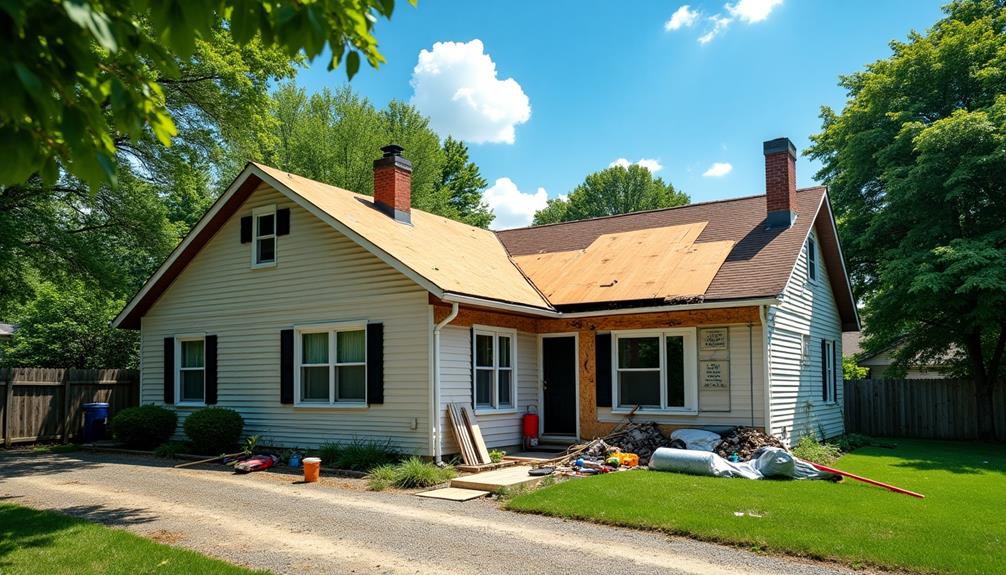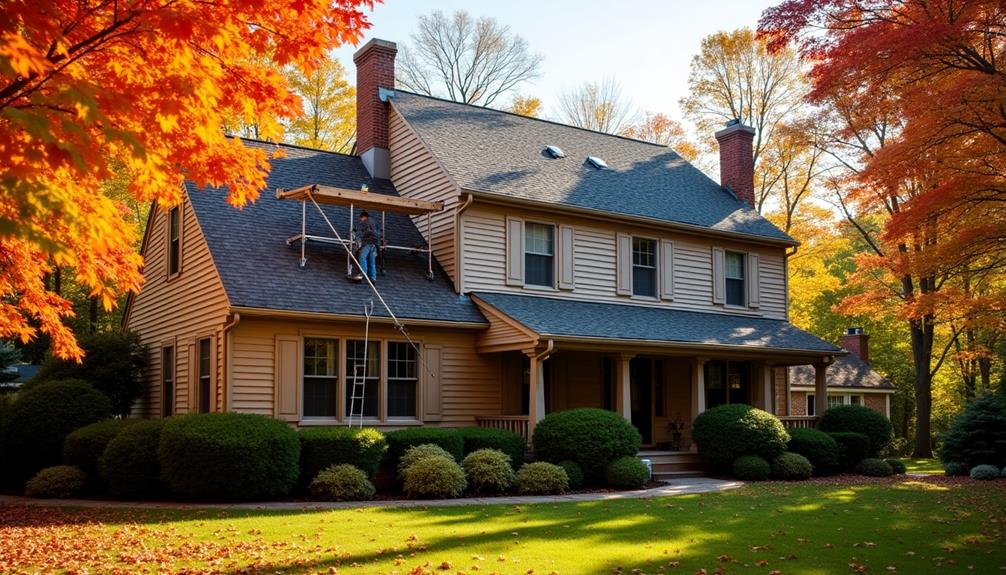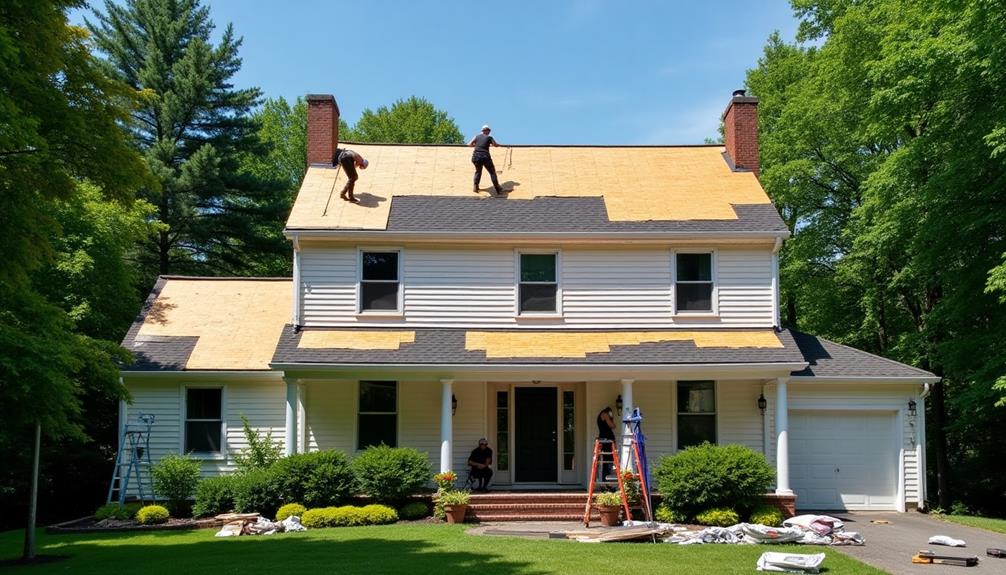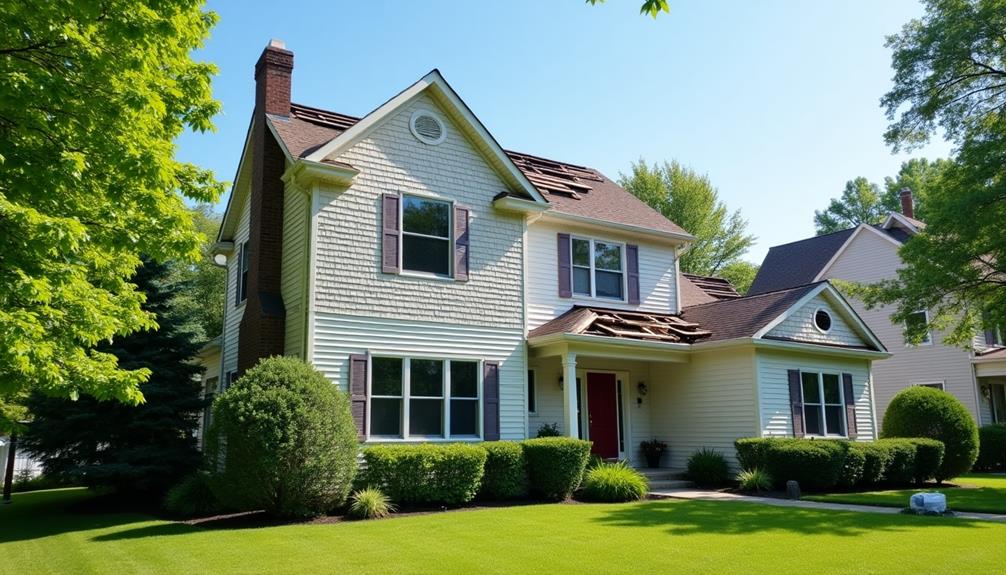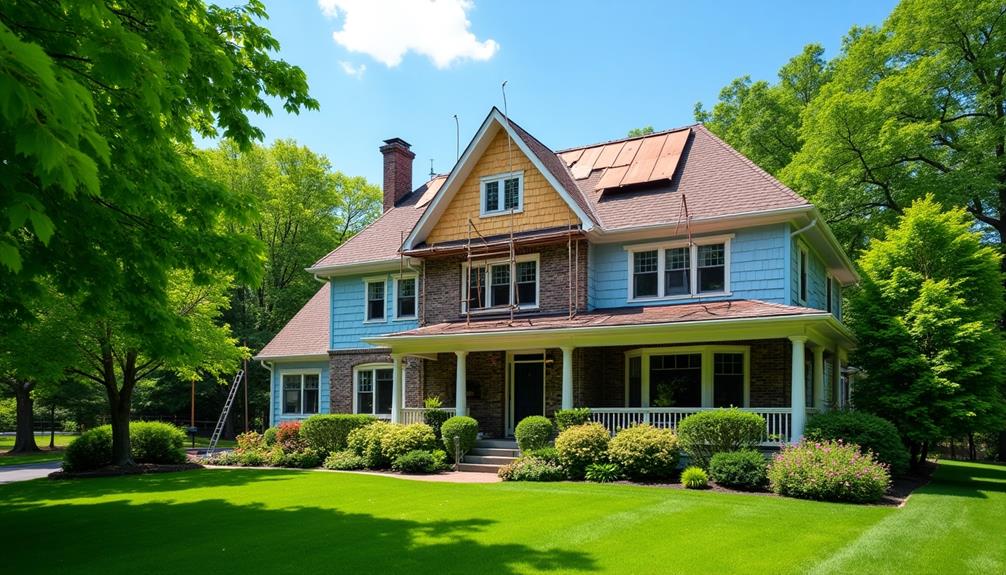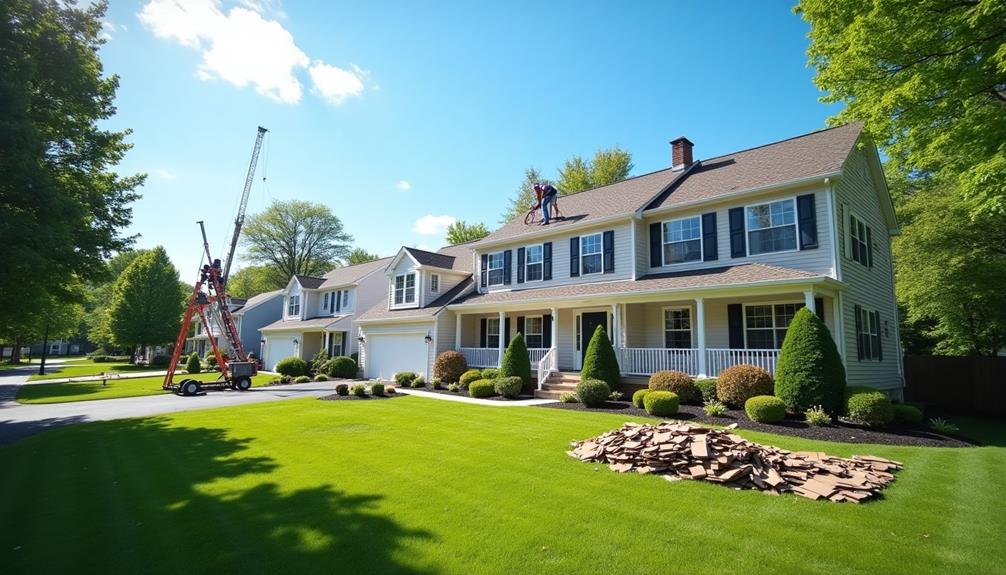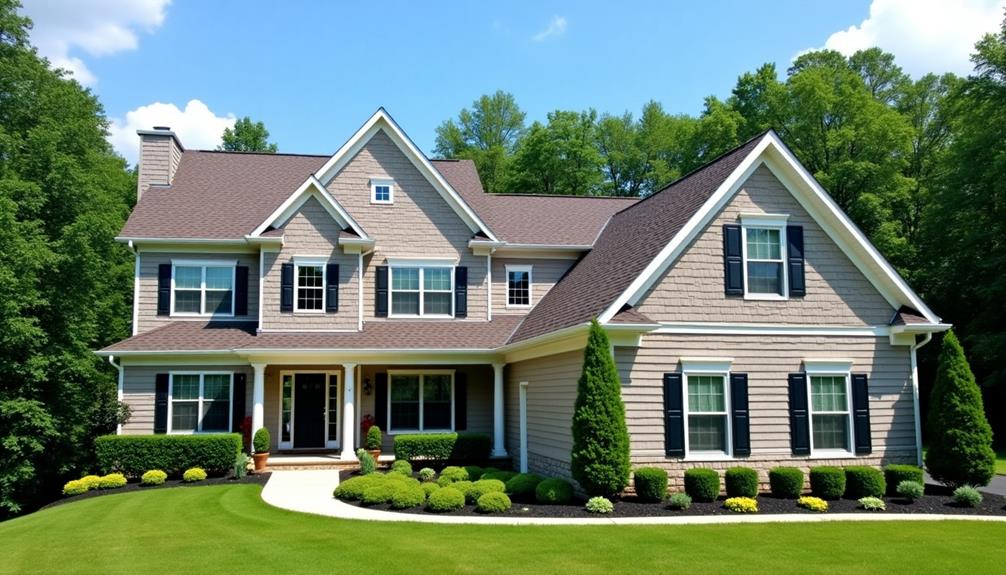Replacing your roof in Maurice River Township, NJ, is essential for maintaining your home's integrity and efficiency. Watch for signs like curling or missing shingles, as they indicate deterioration. Choosing the right material—be it asphalt, metal, or tile—affects longevity and performance. The replacement process involves thorough inspections, proper installation, and effective cleanup. Costs vary based on material and labor, so explore your insurance options. To ensure quality work, research contractors and check reviews. Ongoing maintenance will prolong your roof's life and performance. Discover valuable insights on making the best choices for your replacement project.
Signs You Need a Roof Replacement
Your roof plays a crucial role in protecting your home from the elements, and recognizing the signs that it needs replacement is essential for maintaining that protection.
One of the first indicators is roof age. If your roof is nearing the end of its expected lifespan—typically 20 to 25 years for asphalt shingles—it's wise to evaluate its condition carefully.
Another sign to watch for is weather impact. Frequent storms, heavy snowfall, or intense sunlight can accelerate wear and tear on your roofing materials.
Look for missing or damaged shingles, as this can expose your home to leaks and further damage.
Additionally, check for sagging or uneven areas on the roof's surface, which may indicate structural issues.
Granule loss in the gutters or on the ground below your roof can also signal deterioration, as these granules protect against UV damage.
Lastly, inspect the interior of your home for water stains on ceilings or walls—these stains can be a clear sign that your roof is failing.
If you notice any of these signs, consider consulting a roofing professional to assess the situation and discuss potential replacement options.
Choosing the Right Roofing Material
When selecting roofing materials, you need to consider durability, energy efficiency, and aesthetic appeal.
Each material offers distinct advantages that can impact your home's longevity, comfort, and visual harmony.
Understanding these factors will help you make an informed decision that meets your needs and preferences.
Material Durability Considerations
Selecting the right roofing material is crucial, as it directly impacts the longevity and performance of your roof. When considering material durability, you should prioritize weather resistance, especially in Maurice River Township, where exposure to diverse weather conditions is common.
Materials like asphalt shingles, metal, and slate offer varying levels of resilience against rain, snow, and UV radiation.
Understanding lifespan expectations is essential; for instance, asphalt shingles typically last 15-30 years, while metal roofing can exceed 50 years. Factors like maintenance, installation quality, and local climate will influence these lifespans.
You must also evaluate the material's resistance to issues such as mold, rot, and wind damage. For example, metal roofs aren't only durable but also resistant to pests and mildew, making them a practical choice for long-term durability.
Additionally, consider local building codes and insurance requirements, as specific materials may provide better coverage for weather-related damages.
Energy Efficiency Options
Considering material durability naturally leads to the importance of energy efficiency in roofing choices. When you're selecting roofing materials, it's crucial to consider how they can work with solar panels to maximize energy savings. Installing solar panels on a roof not only provides renewable energy but can also significantly reduce your utility bills.
Additionally, integrating insulation upgrades into your roofing system can enhance energy efficiency. Proper insulation minimizes heat transfer, keeping your home cooler in the summer and warmer in the winter. This not only improves comfort but also reduces the demand on your heating and cooling systems, leading to lower energy costs.
Metal roofs, for instance, are highly reflective, helping to deflect sunlight and maintain a lower temperature inside your home. Meanwhile, materials like asphalt shingles can be paired with reflective coatings to enhance their energy-efficient properties.
Ultimately, the right roofing material and energy-efficient features, such as solar panels and insulation upgrades, won't only protect your home but also contribute significantly to your energy savings and environmental sustainability.
Making informed choices in these areas can lead to long-term benefits for both your wallet and the planet.
Aesthetic Appeal Factors
A beautiful roof can significantly enhance your home's curb appeal and overall value. When choosing the right roofing material, consider how it complements your home's architectural styles. Different materials, such as asphalt shingles, metal, or tile, can create distinct appearances that align with various designs, from traditional to modern.
Color selection is equally crucial. The right color can harmonize with your home's exterior, making it stand out in your neighborhood. Lighter colors typically reflect heat and can be ideal for warmer climates, while darker shades can add depth and richness.
Think about the overall aesthetic you want to achieve: earthy tones may suit a rustic design, while bold colors can accentuate contemporary homes.
Additionally, consider the long-term maintenance of the roofing material you choose. Some options may require more upkeep, which can impact your home's appearance over time.
By carefully evaluating your color choices and how they fit with your home's architectural style, you can ensure your new roof not only adds value but also enhances the overall beauty of your property.
Prioritize these aesthetic appeal factors to make a lasting impression.
The Roof Replacement Process
Before starting your roof replacement, an initial inspection is crucial to assess the current condition and identify any underlying issues.
Once the assessment is complete, the installation process will begin, followed by a thorough cleanup to ensure your property is left in pristine condition.
Understanding these steps will help you prepare for a smooth and efficient roof replacement.
Initial Inspection Steps
When embarking on a roof replacement project, conducting a thorough initial inspection is crucial to identify existing issues and determine the best course of action. Start by assessing the roof age; knowing how long your roof has been in place helps gauge its remaining lifespan and potential need for replacement.
Look for visible signs of wear, such as curling shingles, leaks, or granule loss, which indicate deterioration.
Next, evaluate the structural integrity of the roof. Inspect the rafters and decking for any signs of rot or damage, as these issues can compromise the entire roofing system.
It's also important to check for proper ventilation, as inadequate airflow can lead to moisture buildup and further structural problems.
Take note of any existing repairs or modifications, as these can affect the installation of a new roof. Documenting these findings will assist you in discussing options with your contractor.
Installation and Cleanup Process
The installation process for a roof replacement involves several key steps that ensure a durable and effective result. First, your contractor will remove the existing roofing materials, checking for any underlying damage to the structure beneath.
Effective installation techniques are utilized, such as proper layering and the use of high-quality underlayment to enhance waterproofing. Once the new roofing materials are laid down, attention to detail is crucial to ensure that all components, including flashing and vents, are correctly installed.
As the installation progresses, it's essential to maintain cleanup efficiency. Your contractor will implement strategies to minimize debris and manage waste effectively throughout the project. This involves using tarps and bins to collect discarded materials, ensuring that your property remains safe and tidy.
After installation, a thorough final cleanup is performed, including checking for stray nails and leftover materials.
This meticulous approach not only protects your home but also enhances the aesthetic appeal of your property. By adhering to these installation techniques and maintaining high cleanup efficiency, you can trust that your new roof will provide lasting performance and protection for years to come.
Cost Factors to Consider
Understanding the various cost factors involved in roof replacement can significantly impact your budgeting process. Several elements contribute to the overall expense, and being aware of these can help you make informed decisions.
First, the type of roofing material you choose plays a crucial role. Options like asphalt shingles, metal, or tile vary greatly in cost and longevity.
Additionally, the size and pitch of your roof will affect labor and material costs. Higher roofs or those with complex designs may require more skilled labor, driving up expenses.
Don't forget about insurance coverage. Depending on your policy, your insurance may cover a portion of the replacement cost due to storm damage or wear and tear.
It's essential to review your coverage to understand your potential out-of-pocket expenses.
Lastly, consider financing options. Many contractors offer financing plans that can make the cost more manageable.
Exploring different payment options can help you find a solution that fits your budget while ensuring your home remains protected.
Finding a Reliable Contractor
After assessing the cost factors involved in roof replacement, the next step is to find a reliable contractor who can execute the project effectively. You'll want to research potential candidates thoroughly. Start by checking contractor reviews online to gauge their reputation and quality of work. Look for feedback regarding their professionalism, timeliness, and craftsmanship.
Additionally, ensure that the contractor offers service warranties. A warranty not only protects your investment but also indicates the contractor's confidence in their work. Here's a quick comparison to help you in your decision-making:
| Criteria | Importance |
|---|---|
| Contractor Reviews | Essential for reputation |
| Service Warranties | Critical for protection |
| Experience | Indicates reliability |
Once you've gathered enough information, schedule interviews with your top choices. This will allow you to ask questions about their processes, timelines, and materials used. Don't hesitate to request references from past clients. A reliable contractor will be more than willing to provide this information, ensuring you feel confident in your selection. Taking these steps will help ensure your roof replacement project runs smoothly.
Maintaining Your New Roof
Once your new roof is installed, maintaining it properly is crucial to ensure its longevity and performance. Regular roof care is essential to prevent costly repairs and extend the lifespan of your roofing materials.
Start by conducting seasonal maintenance checks, ideally in spring and fall. During these inspections, look for signs of damage, such as cracked shingles, loose flashing, or debris accumulation.
Clean gutters and downspouts to ensure proper water drainage, which can prevent water pooling on your roof. It's also important to trim overhanging branches to minimize the risk of damage from falling limbs.
If you notice any issues, address them promptly to avoid further complications.
Additionally, consider scheduling professional inspections every few years. Roofers can identify potential problems that may go unnoticed during your own checks.
If you live in an area prone to severe weather, more frequent inspections are advisable.

